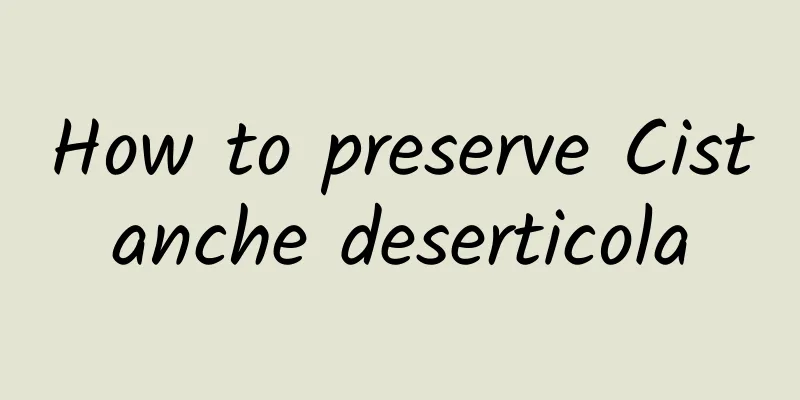How to preserve Cistanche deserticola

|
I believe that in the eyes of many people, many people don’t quite understand what Cistanche deserticola is. In fact, Cistanche deserticola is a common Chinese medicinal herb in our life. This is when people make it into medicine. When Cistanche deserticola is not made into medicine, we can also use it to make many delicacies. The food made with Cistanche deserticola is not only delicious, but also has good taste, and is rich in efficacy, value and nutrition. However, many people don’t know how to preserve Cistanche deserticola after buying it. Let’s take a look at it below. How to preserve Cistanche deserticola Cistanche deserticola is usually packed in sacks, each weighing about 40 kilograms. Store in a dry and ventilated place with humidity below 28% and relative humidity 70-75%. This product is susceptible to mildew and insect infestation. The main warehouse insects that cause harm include medicinal herb beetles, tobacco beetles, and saw-toothed grain beetles. During storage, check regularly. If moisture or slight insect infestation is found, unpack and air dry immediately, or steam with hot steam, air dry, and then repack and store. When the amount is large or the situation is serious, the environment can be sealed and maintained by pumping out oxygen and filling with nitrogen, or fumigating with methyl bromide, aluminum phosphide, etc. Since Cistanche deserticola is a precious Chinese medicinal material, there are many counterfeits on the market. So how do you choose Cistanche deserticola correctly? Let’s take a look at the selection techniques of Cistanche deserticola. Selection tips for Cistanche deserticola Cistanche deserticola is the fleshy stem with scaly leaves of the plant Cistanche deserticola of the Orobanchaceae family. It is mainly produced in sandy soil and semi-sandy grassland areas in Inner Mongolia, Gansu, Xinjiang, Qinghai and other places. Cistanche is a relatively mild tonic with relatively strong tonic power, making it suitable for long-term tonic. Because its tonic effects on humans are similar to those of ginseng, it is known as desert ginseng. The fleshy stem of Cistanche deserticola is long and flat cylindrical, 3 to 15 cm long, 2 to 8 cm in diameter, thick at the bottom and thin at the top. The surface is brown or gray-brown, densely covered with fleshy scales arranged in a shingle-like manner, and the scales are rhombus or triangular. Heavy weight, hard to break. The cross section is brown with light brown dot-like vascular bundles arranged in wavy rings. The wood accounts for about 4/5 of the total and is sometimes hollow. Slight smell, sweet taste, slightly bitter. The best ones are those with thick stripes, densely covered scaly leaves and a soft and smooth texture. There are two types of commercial products: light Cistanche and salty Cistanche. The best light Cistanche are those with large and plump bodies, fine scales, gray-brown to dark-brown color, high oil content, and fleshy and soft stems. The best salty Cistanche is black in color, glutinous in texture, with fine scales and thick stripes, and a flat and round body. Above, we not only introduced how to preserve Cistanche, but also introduced how to select it. This is because many people do not know about Cistanche. If they suddenly hear that eating Cistanche is good for the body, many people will still choose it. However, it is difficult to choose if they don’t know what the food is. But it doesn’t matter. The method we introduced above can allow everyone to choose the best Cistanche. |
<<: What are the functions of Cistanche deserticola
>>: What are the storage and cultivation methods of Cistanche deserticola?
Recommend
Where does the ice in the ice and snow world come from?
Currently, the 26th Harbin Ice and Snow World is ...
The efficacy, function and eating method of bergamot fruit
Buddha's hand fruit is a kind of fruit that c...
The efficacy and function of half maple lotus leaf
Half maple lotus leaf is a common medicinal mater...
The efficacy and function of calyx
As the pressure of modern life increases, more an...
Frostbite! What should I do?
What is frostbite? Which department should I go t...
What are the effects of American ginseng and wolfberry tea formula
American ginseng is one of the most common nouris...
Two Chinese female tourists were hit and killed by a train! They accidentally entered the "death zone" by a pole
Around 3:50 pm on January 9, two Chinese female t...
The efficacy and function of Fushen leaves
The development of Western medicine has brought s...
The efficacy and function of corn bracts
Corn bract is a medicinal material frequently use...
What is the medicinal property of Malan
The amaranth flower is also known as the Malian f...
What are the effects and functions of dried deer antler and how to eat it?
Deer antler is a tonic with excellent nourishing ...
The efficacy and function of Weihan grass
Traditional Chinese medicine has a history of tho...
What are the effects and functions of Artemisia capillaris?
Artemisia capillaris has a good liver-protecting ...







![[Creative Cultivation Program] Gunfire, Bullets and Armor: The MAX Version of the Mantis Shrimp](/upload/images/67f0e4f4a7d19.webp)

